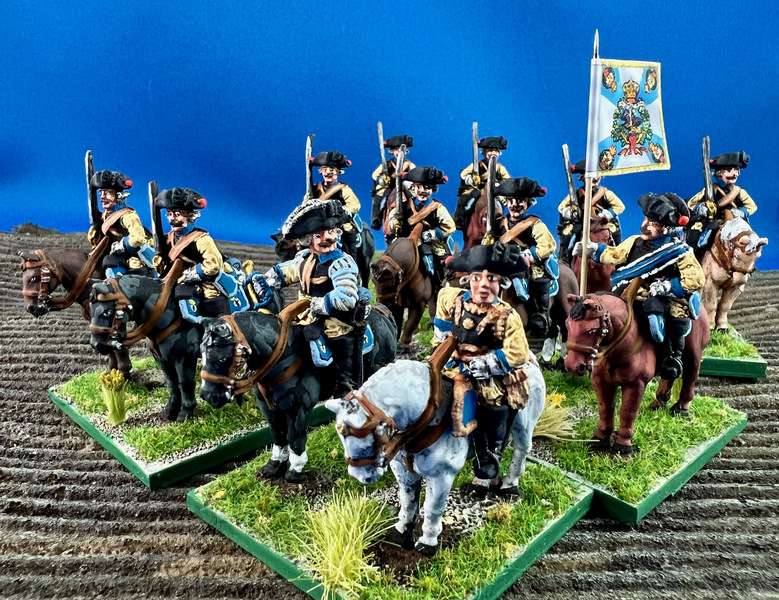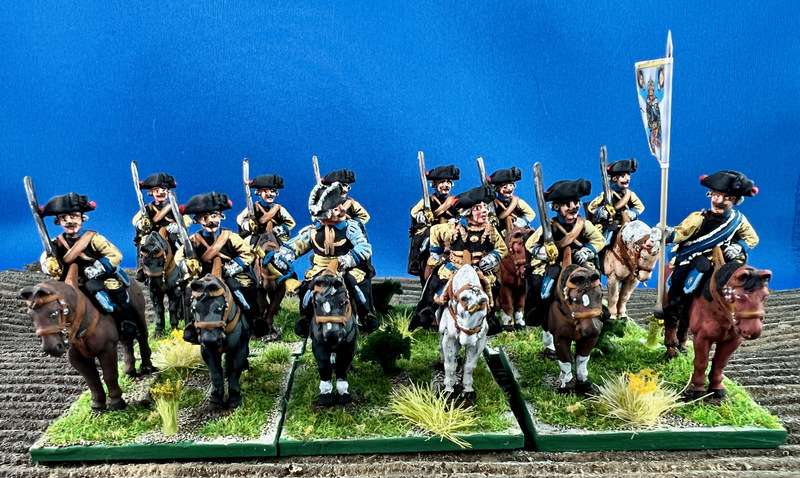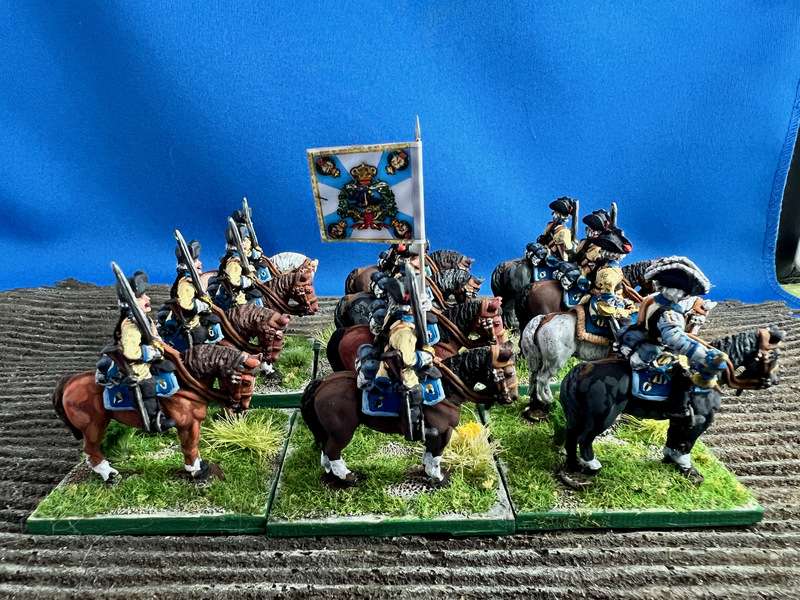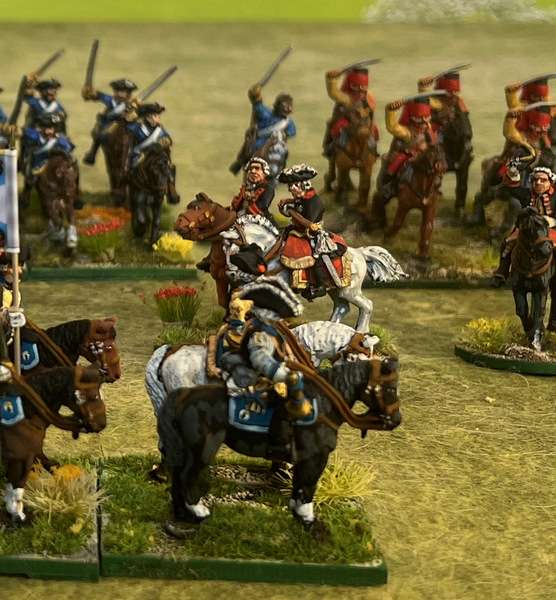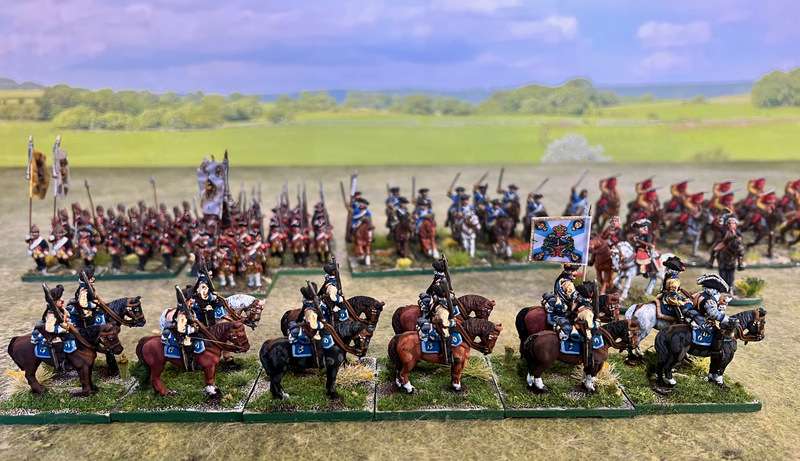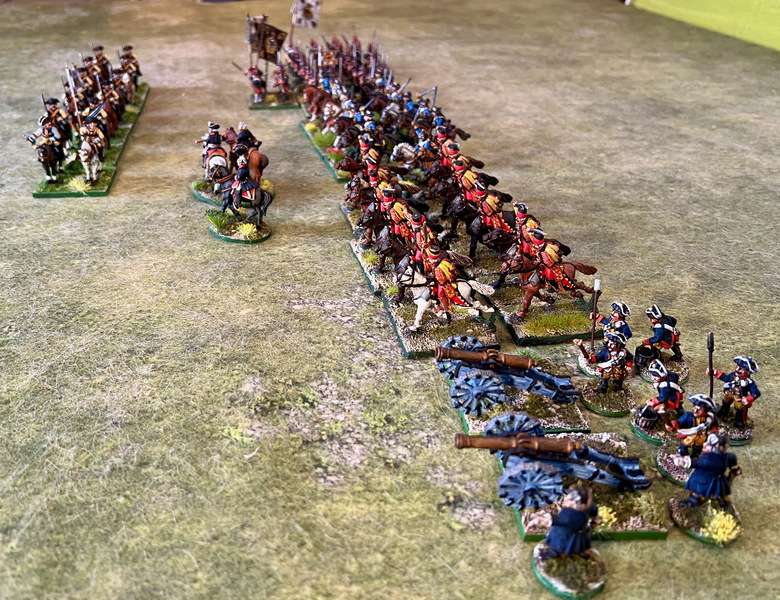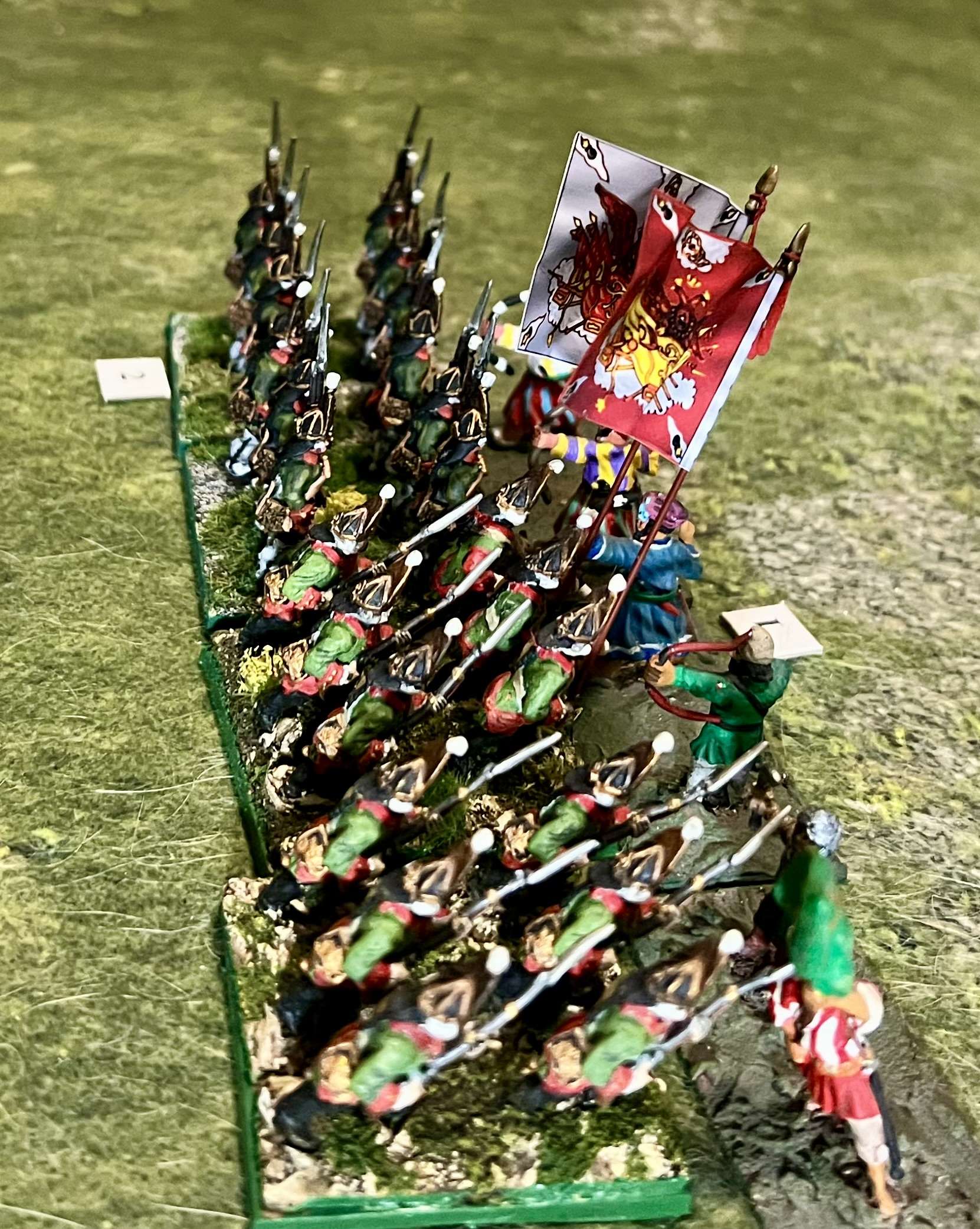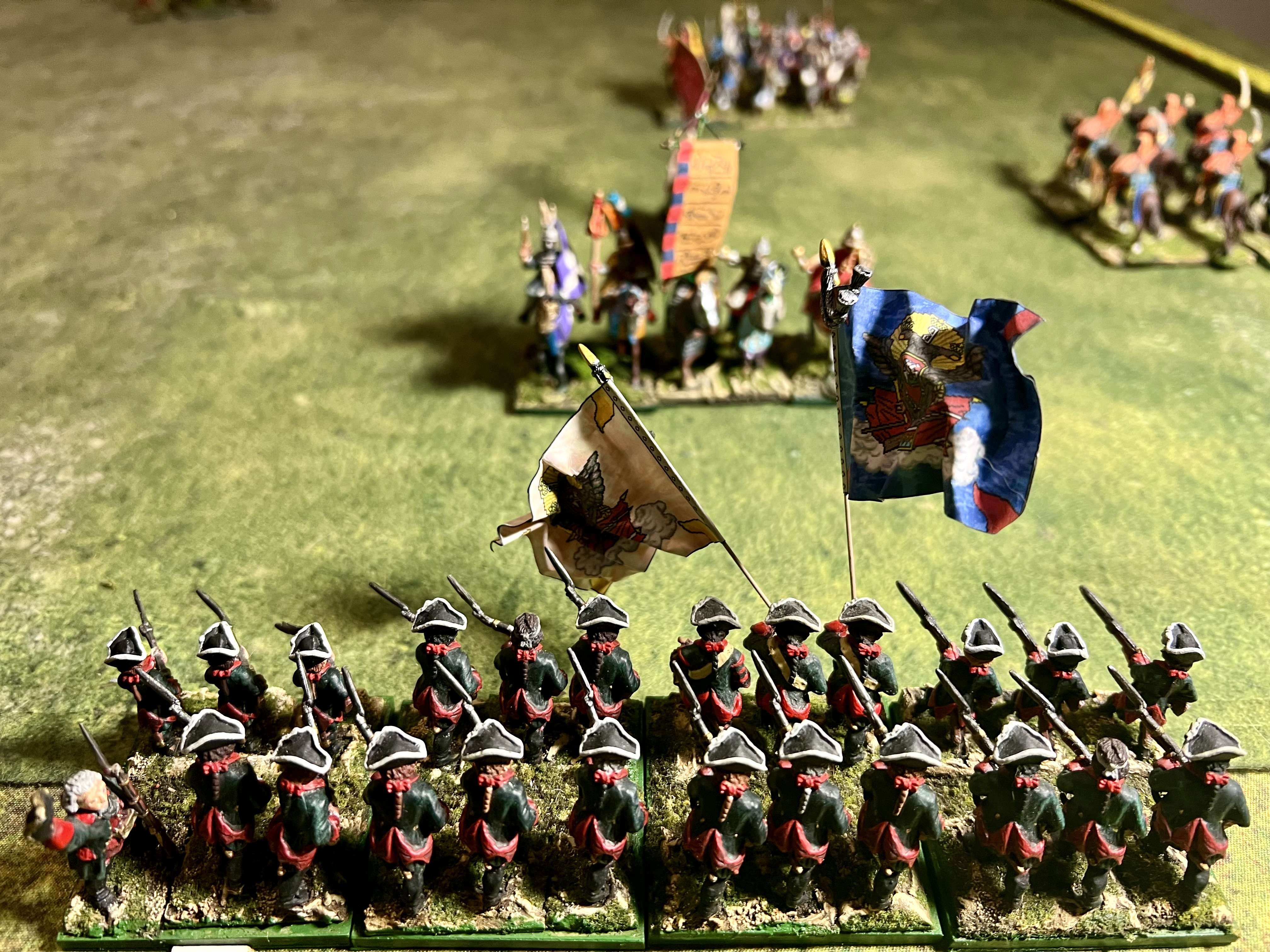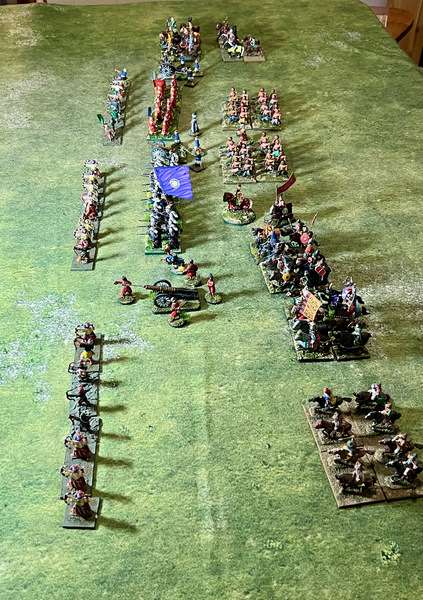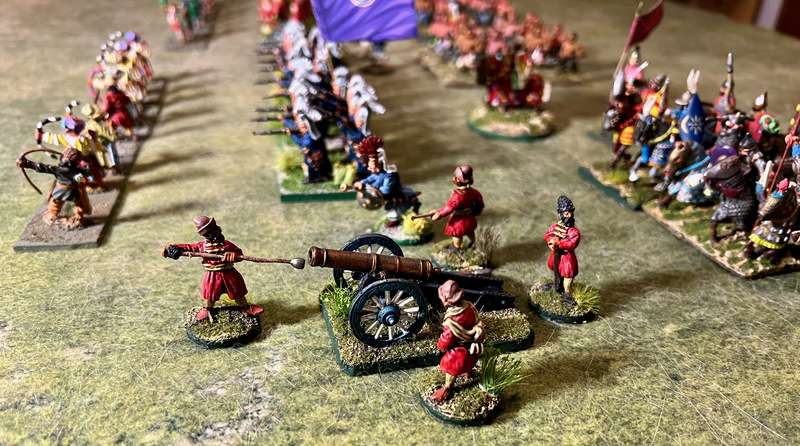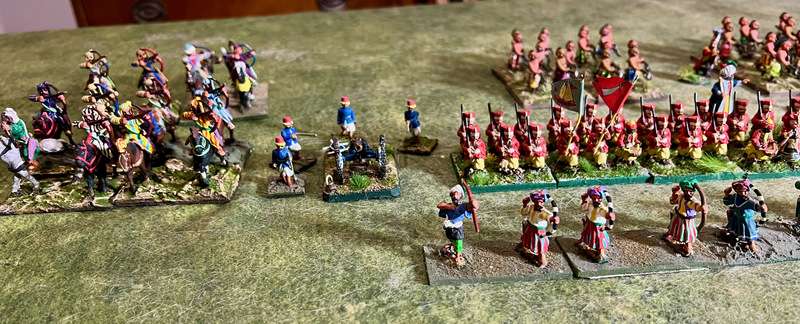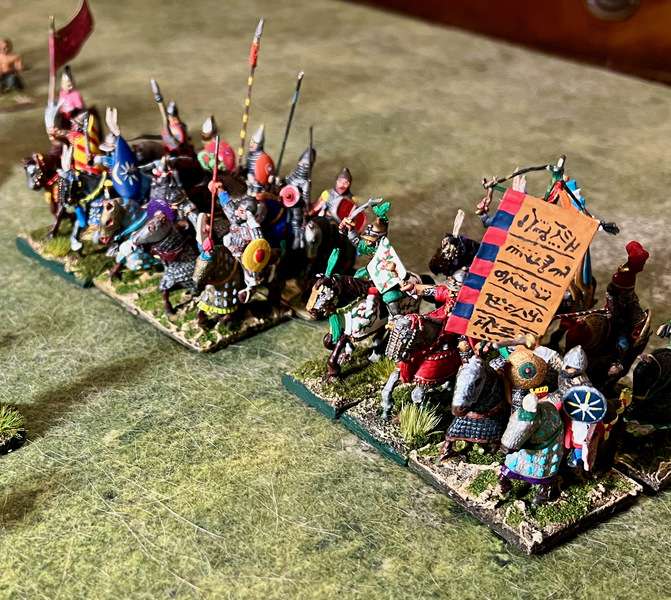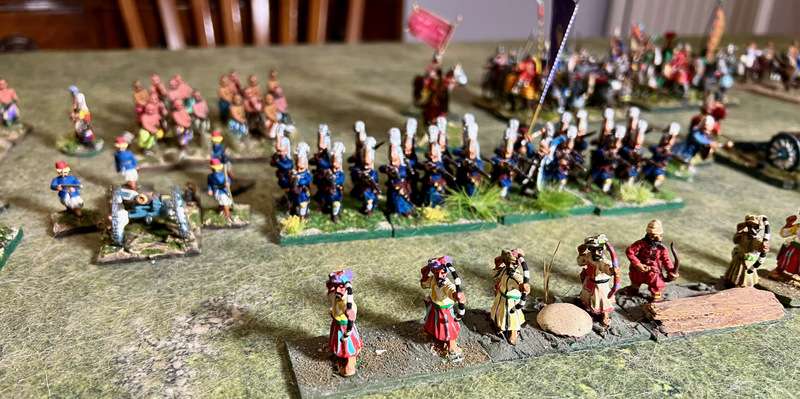Marching out of the basing depot and mustering into the Czar's service is this new regiment for my Russian Seven Years War army. These are 28mm Foundry figures, Russian infantry in red waistcoats, and they fly the banner of the Rostovski Regiment (flags by Adolfo Ramos). They are mostly painted using the Foundry tri-tone system.
The Rostovski Regiment was formed under Peter the Great and fought in several of the big battles in Eastern Prussia, including Gros-Jagsersdorf and Zorndorf.Monday, April 21, 2025
Mustering Into Service: Rostovski Regiment (SYW Foundry Figs)
Thursday, February 13, 2025
Some 28mm Horse and Musket Civilians
Groom leads a horse out of the barn for a gentleman. The groom and horse are from Foundry's 18th century civilian range, the gent in the hat is a Front Rank figure from their Napoleonic civilian range. The barn is I think from Warbases.
MDF cart and cast metal horses from Warbases. The kit includes a resin casting of straw as a load for the cart if one wishes. The farm labourer is from Front Rank's Napoleonic civilians range, enjoying a tankard while stopping at a pub.

Monday, February 10, 2025
Seven Years War Russians in Two Scales
First, a WIP of my latest big project, a 36 figure Russian regiment in waistcoats from the Foundry 28mm SYW range. All my Russian infantry to date are in green coats, so this unit will stand out on the table, and the red is a nice look. If I'm lucky I get a few hours a week to plug away at these guys, and have developed a sort of Zen like attitude towards painting one colour at a time on all 36 figures.
At the same time, I've had a look at these 15mm Russian SYW figures from TundraWorks, a Canadian company based in Ottawa. I ordered an army pack during their Kickstarter last year and have just gotten around to looking at them.
As others have noted online, these pewter figures seem slim, but people also tend to say that they look good when painted. I thought I'd give this batch, also in waistcoats a try.
As things get fraught between Canada and our neighbours to the south, it's good to know that there are home grown sources for figures. Tundraworks has a line of Lace War and Napoleonic figures, which can be ordered from their Kickstarter page, though how one orders seems a little opaque to me.
Cheers and blessings to your brushes, MP+
Saturday, February 8, 2025
New Years Day Seven Years War Battle
CK set up his Russian army, giving his commanders ridiculous names like General Timoshenko Hortonivitch. To stretch my limited collection, we used three base units, which worked well enough: regiments had a decently sized footprint on the table and gave both players enough units to manage while having a decent range of tactical choices.
The Russians had an advantage in infantry: two brigades of three regiments each, while the Prussians had one brigade of four. Both sides had a grenadier regiment, and the rest of the troops were line. The Prussian advantage lay with their better generals. The Honours of War rules are unforgiving with the Russian subcommands, who statistically tend to be worse than their Prussian counterparts. Thus Conrad had three dim and doddering brigade commanders, whereas the Prussians had two competent ones and one dashing general. This would give the Prussians a huge advantage in initiative and twice allowed a Prussian brigade to get an extra move. To offset, I should have given the Russians another battery.
Prussian lines arrayed for battle:
Thursday, December 12, 2024
Prussian Musketeer Regiment Mustered Into Service
I'm very happy that this large Prussian regiment for my SYW project is complete and now mustered into service. These are Foundry 28mm figures, and since they are sculpted wearing jackets without lapels, I painted them as Musketeer Regiment No 3, Anhalt Dessau. This regiment had a mixed war record, but redeemed some earlier fumbles and won back Frederick's regard for its performance at the Battle of Liegnitz.
Here we see the entire regiment drawn up and practicing its musketry drill, under the watchful eye of Der Alte Fritz. That parade ground looks quite idyllic!
Friday, August 30, 2024
Some SYW Front Rank Russians
Another short post to show off some projects completed over this summer.
My Seven Years project uses 6 infantry figures on a 2x2" base to give the nice packed ranks that I associate with the period. As part of breathing new life into units painted long ago, and now being rebased, I needed some more figures to flesh out my Russian units. I remain deeply thankful that Gripping Beast picked up the Front Rank range, which I started collecting some three decades ago, but in small numbers as I was on a graduate student budget at the time. Now I can afford to pick up more of these castings to bring the units up to the new standard.
These are painted in the famous red gaiters of the Apsheronsky Regiment, which was apparently awarded them as an honour after Kunersdorf where they "fought up to their knees in blood". The story is undoubtedly exaggerated but it's a nice piece of visual chrome for the tabletop.
Thanks for looking and blessings to your brushes!
MP+
Saturday, August 17, 2024
EX THUNDERING DICE 2-24: A Wargames Weekend
It was also a chance to give James this piece for his Napoleonics collection, a 28mm Front Rank figure, Archduke Charles, for James' Austrian force. Seeing as James usually plays Sharp Practice, the Archduke may qualify as the biggest of Big Men. He certainly has a big hat! He's painted using the Foundry tritone system. I don't paint or collect 28mm Napoleonics, but Front Rank's figures may yet tempt me.
Wednesday, April 3, 2024
Front Rank 28mm SYW Prussian Cuirassiers Swell the Ranks
A bunch of Front Rank swells swell the ranks. Trotting off the paint bench are these 12 figures, representing the 5th Margrave Friedrich von Brandenburg Cuirassiers. They been consuming my time off and on since just after Christmas and I'm happy to get to the finish line with them.
As noted, the figures are Front Rank, and I'm so glad that this venerable line of figures was picked up by Gripping Beast. I just chose the regiment because I like the number 5, and liked the blue on beige uniforms. I used this page from the invaluable Kronoskaf website as a guide. The flag is from Adolfo Ramos and the paints used are mostly from the Foundry tri-tone system.
The newly mustered regiment passes in review in front of Der Alte Fritz and are cheered lustily by their cavalry colleagues.
Some shots of my completed Prussian army thus far.
Next in the Prussian Painting Queue (PPQ) is another musketeer regiment (No 3 Anhalt-Dessau) and some pesky friekorps, including Von Kleist's uhlans (very pretty, but can they fight?).
Thanks for looking and blessings to your brushes!
MP+
Monday, March 25, 2024
First Thoughts on Henry Hyde's Shot, Steel and Stone Miniatures Rules
Not that they are especially new, but I've spent the last few weeks learning a set of horse and musket rules by Henry Hyde called Shot, Steel and Stone (SS&S). I've been looking for a good set of rules suitable for the Seven Years War period, and added SS&S to my shopping cart when I was buying some books on the Caliver website. They are also available on the Wargames Vault webstore, and are fairly inexpensive.
My first impression of SS&S was that the subtitle, "The Bare Essentials", described it well. The black and white book weighs in at about twenty-ish pages but was attractively bound in a soft cardboard cover. The B&W photos show ranks of the old school figures that Henry unabashedly loves, and help give these rules their nostalgic feel. However, Henry's been busy augmenting these rules with a whole set of "how to" videos on his You Tube channel, done in his loquacious and enthusiastic style.
Since I had my Turkish 18th century army on the table (see my previous post here), I decided to put my Russian troops down and have a go. This may have been a mistake, as it's always better to learn a new set of rules with fewer units, but I couldn't resist the visual appeal. As you can see, I didn't put any terrain down, as I wanted to focus on the core mechanics.
Here are four things I especially liked about these rules.
1) Limited Friction. Commanders and subcommanders can have three ratings, basically Good, Average, and Poor, which determine their command radii and the bonuses they can give their troops. However, at the start of each turn, each commander's ability is checked by a die roll, meaning that even good commanders can have a bad moment, and vice versa. This effectiveness check imposes a limited friction on the battle, so that a bad roll means that a commander's units will move more slowly and be less reliable in melee, or (again), vice versa. Thus, a wing of the army will not lose a turn, as in some other rule sets where initiative rolls are required, but that wing might perform erratically to the good or bad.
2) Basing Agnostic. Like other rules sets, bases don't have to be of a certain size as long as the size is standard, and movement and range is measured in base lengths (my bases are generally 2 inch squares, so that's easy to work out). Unit strength is measured by a number of bases. Bases can be removed by shooting hits or by melee results. Large units have better morale than smaller ones, and generally when a unit gets to half its original strength, it's basically spent and will retire. Each base gets so many dice for shooting or for melee.
3) Morale System. In SS&S units have three levels of quality, A (elite), B (line) and C (poor). Morale checks are taken before charging, when being charged, after melee and after shooting hits are taken, etc. The quality of the unit and its size are among a range of factors that determine the morale check modifier, including: unit posture (eg, advancing or retreating), hits taken that turn, current size vs starting size, formation (eg, skirmish vs close order), threats to flank and presence and proximity of supporting units.
That sounds like a lot to calculate, and will remind older players of WRG rules sets and the days of yore, but Henry's supplied a clever little matrix that makes the process fairly easy to work through.
Of course, the dice will be perverse. Here my Elite (A Class) Russian grenadiers caught a unit of Poor (C Class) Ottoman skirmish bow in a charge and amazingly the skirmishers held their ground and fought the grenadiers to a standstill, with casualties tied on both sides. Of course, two of those grenadier bases were newly painted and having their first outing, so the new unit curse naturally applies.
4) Disruptions
Friday, March 22, 2024
Ottomans On Parade: A Resurrected Army
Some years ago I started something called the Resurrected Armies Project, where I would revisit an old wargaming project and try to breathe some life in it, assuming that the project made the cut (my 20mm WW2 collection was rehomed rather than resurrected, but that's another story).
Recently, after finishing a unit of Assault Group janissaries as seen in my previous post here, I wanted to see how my entire Ottoman army looked on the table. Some of these figures are quite old, and some, like an ancient Minifigs janissary regiment (the chaps in red) have been recently rebased. There's more cavalry rebasing to do.
Here's the entire army.
The heavy gun. I have no idea what make of figures the gunners are.
The flower of the Sultan's cavalry. There are a few Assault Group spahis mixed in with God knows what else. As you can tell from the banner, my Arabic is a bit rusty.
Newer janissary regiment and behind them some bare chested fellows, once dubbed the "Turkish love slaves" in a game ages ago






































